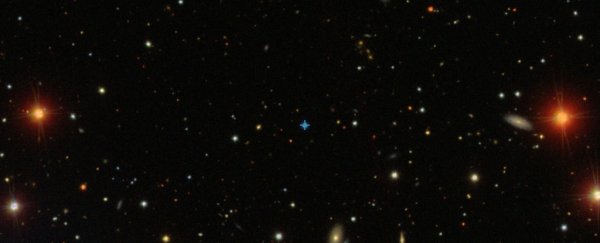A new discovery relating to a rogue star may have just given astronomers a clue towards one of the weirdest mysteries associated with black holes: Where are the middle-sized ones?
We know that stellar-mass black holes exist at up to 100 times the mass of the Sun, and supermassive black holes exist that are over 100,000 times the mass of the Sun. In between those two weight classes? Nothing but the occasional tantalising hint.
Now we have a new hint, and it involves another of our favourite space things: a runaway star, kicked out of the Milky Way's disc on a trajectory towards intergalactic space.
The object is called PG 1610+062, and when it was discovered in the galactic halo in 1986, it was thought to be pretty typical of galactic halo stars: old, puffy, about half the mass of the Sun, and past the point of hydrogen fusion. It was also moving pretty fast - almost fast enough to escape the Milky Way (but not quite).
New observations in 2011 revealed that the star is not old at all; in fact, it's quite young, still fusing hydrogen, and much more massive than thought - 10 times the mass of the Sun. In other words, a B-type main-sequence star. It was reclassified in 2015.
Simulations in 1988 described something called the Hills mechanism, whereby a three-body exchange interaction involving a supermassive black hole and a binary star can kick a star into hypervelocity speeds. The black hole captures one of the binary pair, flinging the other out into space.
It was thought that this was the only mechanism capable of producing hypervelocity main-sequence stars, so PG 1610+062's trajectory was thought to be a result of this process, where the black hole was Sagittarius A*, the supermassive black hole at the heart of our galaxy.
But then the Gaia data releases happened, with the most accurate three-dimensional maps of our galaxy ever produced. And these revealed that PG 1610+062 is not where astronomers had previously thought, but farther away.
So, an international team of astronomers led by Andreas Irrgang of the Friedrich-Alexander University in Germany decided to take a closer look, using the W. M. Keck Observatory's Echellette Spectrograph and Imager to try and analyse the star's chemical composition, and place constraints on its rotational velocity (its spin) and its radial velocity (its velocity in relation to the observer - us).
Their spectroscopic analysis revealed that PG 1610+062 is rather rich in metals, confirming that it is indeed a young star, since older stars have less metallicity.
But they also found, based on the star's velocity, that it started out nowhere near the galactic centre. They traced its birthplace to the Carina-Sagittarius spiral arm, where, they believe, it was ejected at a velocity of around 550 kilometres per second.
And that's also interesting. Because that means it's a high-velocity star, not a hypervelocity star, which have velocities in excess of 1,000 kilometres per second.
A hypervelocity star travelling away from the galactic centre at 1,700 kilometres per second was discovered earlier this year, so we know Sgr A* can deliver a heftier kick than 550 kilometres per second.
But other methods of stellar ejection - gravitational interactions in tight star clusters, or supernova of one star in a binary pair - aren't powerful enough, especially since PG 1610+062 is moving against the galaxy's rotation.
And that's where we come back to the black hole mystery. The star's velocity opens the possibility it was turfed out of its place by one of those elusive intermediate-mass black holes.
"Close encounters with very massive stars or intermediate-mass black holes offer, in principle, a straightforward explanation," the researchers wrote in their paper.
"However, the rates at which those strong dynamical interactions may occur are not well constrained because the actual number of massive perturbers and the conditions in their host clusters are uncertain."
Only a small number of these main-sequence high-velocity runaway stars are known. This new research presents a compelling case for finding more of them. Find the stars, and we may find those missing black holes. And if we don't, we may find something else just as cool.
The research has been published in Astronomy & Astrophysics.
